The global pharmaceutical continuous manufacturing equipment market is valued at USD 1,496.4 million in 2025. It is slated to reach USD 3,742.5 million by 2035, recording an absolute increase of USD 2,246.1 million over the forecast period. This translates into a total growth of 150.1%, with the market forecast to expand at a CAGR of 9.6% between 2025 and 2035.
The overall market size is expected to grow by nearly 2.5 times during the same period, supported by increasing demand for efficient drug production technologies, the growing adoption of automated manufacturing processes in pharmaceutical facilities, and a rising preference for cost-effective production methods across diverse pharmaceutical applications.
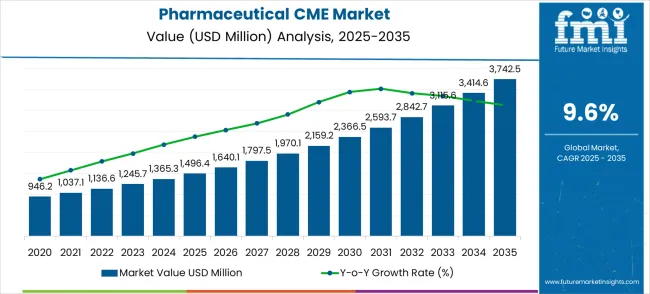
Between 2025 and 2030, the pharmaceutical continuous manufacturing equipment market is projected to expand from USD 1,496.4 million to USD 2,366.5 million, resulting in a value increase of USD 870.1 million, which represents 38.7% of the total forecast growth for the decade. This phase of development will be shaped by increasing pharmaceutical industry modernization, rising adoption of advanced process control technologies, and growing demand for regulatory-compliant manufacturing solutions in drug development and production facilities. Pharmaceutical manufacturers are expanding their continuous manufacturing capabilities to address the growing demand for efficient production systems and quality assurance protocols.
| Metric | Value |
|---|---|
| Estimated Value in (2025E) | USD 1,496.4 million |
| Forecast Value in (2035F) | USD 3,742.5 million |
| Forecast CAGR (2025 to 2035) | 9.6% |
The pharmaceutical industry leads the market, contributing 50-55%, as continuous manufacturing allows for more efficient drug production with fewer batch changes and less downtime. This helps pharmaceutical companies streamline production, ensure consistent product quality, and comply with stringent regulatory standards. The biopharmaceuticals segment plays a crucial role, accounting for 20-25%, as continuous manufacturing is especially beneficial for the production of biologics, offering a reliable and scalable process while maintaining high product quality and minimizing waste. Contract manufacturing organizations (CMOs) contribute 15-18%, as they increasingly adopt continuous manufacturing equipment to provide cost-effective solutions for small to large-scale drug production, meeting the demand for faster production timelines.
The research and development sector adds 10-12%, with pharmaceutical companies and academic institutions exploring continuous manufacturing methods to improve efficiency, reduce operational costs, and scale production processes. The other segment, including government agencies, regulatory bodies, and the pharmaceutical supply chain, contributes 5-8%, supporting the transition to continuous manufacturing through regulatory frameworks, training, and policy development.
Market expansion is being supported by the increasing global demand for cost-effective drug production and the corresponding need for advanced manufacturing technologies that can deliver consistent product quality and reduced production timelines while maintaining regulatory compliance across various pharmaceutical applications. Modern pharmaceutical manufacturers are increasingly focused on implementing production solutions that can reduce manufacturing costs, minimize waste generation, and provide real-time quality monitoring in drug production facilities. Continuous manufacturing equipment's proven ability to deliver operational efficiency, enhanced process control, and versatile production applications makes it an essential component for contemporary pharmaceutical manufacturing and drug development solutions.
The growing focus on regulatory compliance and product quality assurance is driving demand for continuous manufacturing equipment that can support process validation requirements, enable real-time release testing, and provide comprehensive documentation for regulatory submissions. Pharmaceutical processors' preference for manufacturing technologies that combine operational efficiency with regulatory compliance and cost-effectiveness is creating opportunities for innovative continuous manufacturing implementations. The rising influence of personalized medicine and small-batch production trends is also contributing to increased adoption of flexible manufacturing equipment that can provide scalable production solutions without extensive facility modifications.
The market is segmented by device type, application, and region. By device type, the market is divided into dryers, granulators, mixers, reactors, and others. Based on application, the market is categorized into medicines and health products. Regionally, the market is divided into North America, Europe, East Asia, South Asia & Pacific, Latin America, and the Middle East & Africa.
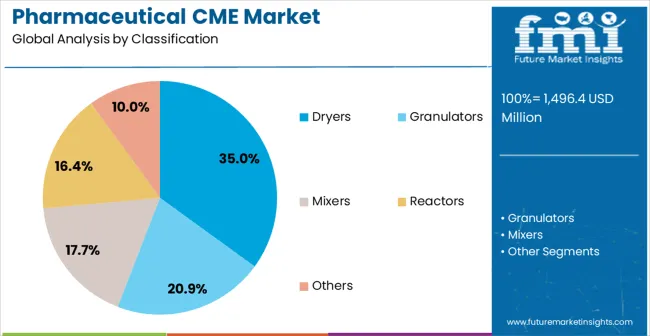
The dryers segment is projected to account for 35% of the pharmaceutical continuous manufacturing equipment market in 2025, reaffirming its position as the leading device category. Pharmaceutical manufacturers increasingly utilize continuous dryers for their superior moisture control capabilities, enhanced product uniformity, and efficiency in solvent removal applications across tablet production, granulation processes, and active ingredient processing. Continuous drying technology's advanced process control capabilities and consistent performance output directly address the industrial requirements for reliable moisture management and operational efficiency in large-scale pharmaceutical production.
The device segment forms the foundation of modern pharmaceutical manufacturing operations, as it represents the equipment with the greatest versatility and established market demand across multiple drug production categories and manufacturing applications. Processor investments in enhanced heat transfer technologies and process monitoring systems continue to strengthen adoption among pharmaceutical manufacturers. With companies prioritizing consistent product quality and regulatory compliance, continuous dryers align with both operational efficiency objectives and quality assurance requirements, making them the central component of comprehensive pharmaceutical manufacturing strategies.

Medicine applications are projected to represent 71.2% of pharmaceutical continuous manufacturing equipment demand in 2025, underscoring their critical role as the primary commercial consumers of advanced manufacturing technologies for drug production, formulation development, and active ingredient processing. Pharmaceutical companies prefer continuous manufacturing equipment for its cost-effectiveness, consistent quality output, and ability to enhance production efficiency while reducing batch-to-batch variability and manufacturing timelines. Positioned as essential technologies for modern drug manufacturing, continuous equipment offers both operational advantages and quality benefits.
The segment is supported by continuous innovation in pharmaceutical process development and the growing availability of specialized manufacturing technologies that enable advanced drug production with enhanced regulatory compliance capabilities. Pharmaceutical manufacturers are investing in process optimization systems to support large-scale production requirements and quality assurance protocols. As regulatory requirements become more stringent and production efficiency demands increase, medicine applications will continue to dominate the end-user market while supporting advanced manufacturing utilization and product development strategies.
The pharmaceutical continuous manufacturing equipment market is advancing rapidly due to increasing regulatory pressure for quality improvements and growing adoption of advanced manufacturing technologies that provide enhanced process control and operational efficiency across diverse pharmaceutical production applications. The market faces challenges, including high initial capital investment requirements, complex validation procedures for regulatory approval, and the need for specialized technical expertise for equipment operation. Innovation in process analytical technology and automated control systems continues to influence product development and market expansion patterns.
The growing adoption of real-time monitoring and process analytical technology is enabling pharmaceutical manufacturers to implement premium continuous manufacturing equipment with superior process control, enhanced quality assurance, and automated release testing capabilities. Advanced analytical systems provide improved product consistency while allowing more efficient production monitoring and regulatory compliance across various drug manufacturing processes and product categories. Manufacturers are increasingly recognizing the competitive advantages of integrated analytical capabilities for product differentiation and regulatory approval acceleration.
Modern pharmaceutical continuous manufacturing equipment producers are incorporating artificial intelligence algorithms and machine learning capabilities to enhance process optimization, reduce production variability, and enable predictive maintenance across various manufacturing scenarios and production environments. These technologies improve operational efficiency while enabling new applications, including adaptive process control, real-time quality prediction, and automated troubleshooting capabilities. Advanced AI integration also allows manufacturers to support premium equipment positioning and operational optimization beyond traditional manufacturing requirements.
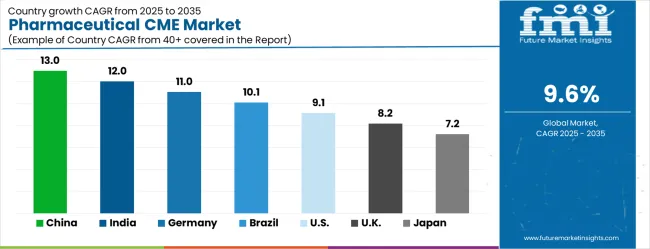
| Country | CAGR (2025-2035) |
|---|---|
| China | 13.0% |
| India | 12.0% |
| Germany | 11.0% |
| Brazil | 10.1% |
| USA | 9.1% |
| UK | 8.2% |
| Japan | 7.2% |
The pharmaceutical continuous manufacturing equipment market is experiencing strong growth globally, with China leading at a 13.0% CAGR through 2035, driven by the expanding pharmaceutical industry, growing investment in manufacturing modernization, and significant development of generic drug production infrastructure. India follows at 12.0%, supported by rapid pharmaceutical sector expansion, increasing contract manufacturing capabilities, and growing adoption of advanced production technologies. Germany shows growth at 11.0%, emphasizing pharmaceutical innovation and premium equipment development. Brazil records 10.1%, focusing on pharmaceutical manufacturing expansion and healthcare infrastructure development. The USA demonstrates 9.1% growth, prioritizing advanced drug development and regulatory compliance technologies. The UK exhibits 8.2% growth, emphasizing pharmaceutical research and development capabilities. Japan shows 7.2% growth, supported by precision manufacturing and advanced pharmaceutical component development.
The report covers an in-depth analysis of 40+ countries with top-performing countries are highlighted below.
The pharmaceutical continuous manufacturing equipment in China market is set to grow at a robust CAGR of 13.0% from 2025 to 2035. As one of the largest pharmaceutical markets globally, China’s shift towards continuous manufacturing processes in the pharmaceutical industry is poised to significantly enhance production efficiency and quality. The government's focus on modernizing the healthcare infrastructure, along with incentives for technological advancements, supports the demand for continuous manufacturing equipment. China’s rapid pharmaceutical growth, driven by both domestic consumption and international exports, further drives the adoption of these advanced manufacturing technologies. As the country aims to reduce manufacturing costs and increase drug production speed, pharmaceutical companies are increasingly investing in continuous manufacturing solutions.
The pharmaceutical continuous manufacturing equipment market in India is anticipated to grow at a CAGR of 12.0% from 2025 to 2035. India, as a major pharmaceutical manufacturing hub, is increasingly adopting continuous manufacturing technologies to meet both domestic and global demand for affordable, high-quality medicines. The Indian pharmaceutical industry is expanding rapidly, aided by government initiatives such as the "Make in India" campaign, which fosters local manufacturing capabilities. India’s rising focus on quality standards and regulatory compliance in the pharma sector is increasing the adoption of modern manufacturing equipment. Continuous manufacturing offers significant advantages in terms of reducing production costs, increasing product consistency, and improving overall production capacity. The increasing trend of contract manufacturing and pharmaceutical outsourcing in India is also expected to contribute to the market's growth.
The pharmaceutical continuous manufacturing equipment in Germany is market is projected to grow at a CAGR of 11.0% from 2025 to 2035. As a global leader in pharmaceutical innovation and manufacturing, Germany is embracing continuous manufacturing technologies to enhance production efficiency and ensure high-quality standards. The country’s pharmaceutical industry is rapidly evolving, with a focus on reducing production costs, improving speed to market, and ensuring regulatory compliance. Germany’s well-established industrial base and advanced technological infrastructure provide a solid foundation for the growth of continuous manufacturing solutions. With increasing focus on precision, efficiency, and scalable production, German pharmaceutical companies are adopting these advanced systems for large-scale drug production. The demand for personalized medicine and biologics is also contributing to the adoption of continuous manufacturing systems, making it a key area of growth for the German pharmaceutical sector.
Demand for pharmaceutical continuous manufacturing equipment is expected to grow at a CAGR of 10.1% from 2025 to 2035. Brazil’s pharmaceutical industry, one of the largest in Latin America, is undergoing modernization, with companies increasingly focusing on improving production efficiency and reducing manufacturing costs. Continuous manufacturing equipment offers a key solution to meet these goals, enabling more consistent product quality and faster production times. Brazil's growing pharmaceutical export market is also a driving factor, as companies look to comply with global standards and improve their competitive edge. Brazil's evolving regulatory environment, with stricter adherence to international quality standards, further drives the demand for these advanced manufacturing systems. The adoption of continuous manufacturing technologies is also aided by Brazil’s growing healthcare sector, which requires efficient production capabilities to meet the rising demand for medications.
The pharmaceutical continuous manufacturing equipment market in the USA is projected to grow at a CAGR of 9.1% from 2025 to 2035. The USA, being a leading pharmaceutical market, is increasingly investing in continuous manufacturing technologies to meet both the regulatory requirements and the demand for high-quality pharmaceutical products. The key drivers for this growth include the rising focus on reducing production costs, enhancing efficiency, and meeting the growing demand for biologics and personalized medicine. The US pharmaceutical industry is also embracing automation and advanced production techniques to ensure scalability and consistency. As the FDA and other regulatory bodies emphasize manufacturing innovations, US companies are investing in continuous manufacturing solutions to meet stringent guidelines. The rise of contract manufacturing organizations in the US is also contributing to the market's expansion.
The Pharmaceutical Continuous Manufacturing Equipment market in the UK is expected to grow at a CAGR of 8.2% from 2025 to 2035. The UK pharmaceutical industry is undergoing a significant transformation with a growing focus on operational efficiency, product quality, and compliance with international standards. Continuous manufacturing technologies are gaining traction in the UK as pharmaceutical companies seek to enhance production capabilities and reduce costs. With the rise in biologic drug production and the need for scalable solutions, the UK market is seeing a surge in demand for continuous manufacturing systems. The government's initiatives to support innovation in the pharmaceutical sector, along with advancements in regulatory frameworks, are expected to provide ample opportunities for market expansion.
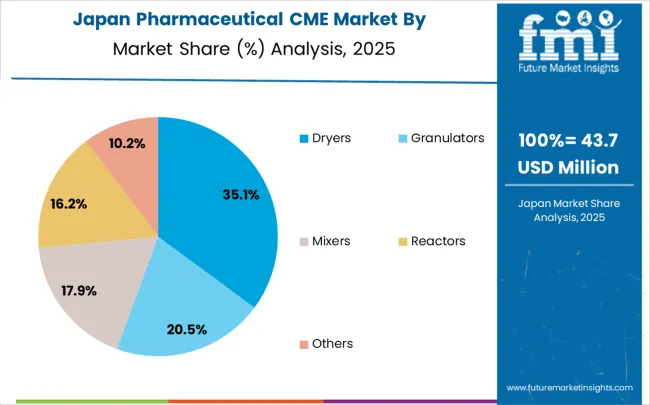
Japan’s Pharmaceutical Continuous Manufacturing Equipment market is forecast to grow at a CAGR of 7.2% from 2025 to 2035. Japan’s pharmaceutical sector, known for its high standards and advanced technology, is increasingly adopting continuous manufacturing equipment to improve production efficiency and reduce costs. The country’s aging population and rising healthcare needs are creating a growing demand for both generic and innovative pharmaceutical products, further driving the market for advanced manufacturing systems. Japanese pharmaceutical companies are investing in continuous manufacturing to meet the demands for high-quality products while maintaining competitive prices. Japan's adherence to stringent regulatory standards and focus on improving manufacturing processes will continue to support the adoption of these systems.
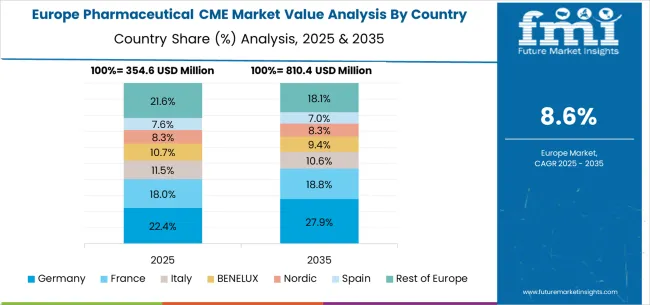
The pharmaceutical continuous manufacturing equipment market in Europe is projected to grow from USD 299.3 million in 2025 to USD 748.5 million by 2035, registering a CAGR of 9.6% over the forecast period. Germany is expected to maintain its leadership position with a 32.0% market share in 2025, moderating slightly to 31.5% by 2035, supported by its strong pharmaceutical industry, advanced manufacturing technology development, and comprehensive pharmaceutical equipment supply network serving major European markets.
The United Kingdom follows with a 24.0% share in 2025, projected to reach 24.3% by 2035, driven by robust demand for pharmaceutical manufacturing equipment, biotechnology sector development, and advanced drug development capabilities, combined with established pharmaceutical companies implementing continuous manufacturing technologies. France holds an 18.0% share in 2025, expected to increase to 18.2% by 2035, supported by strong pharmaceutical manufacturing and growing focus on generic drug production, but facing competitive pressures from German and Swiss equipment suppliers. Italy commands a 12.0% share in 2025, projected to reach 12.1% by 2035, while Spain accounts for 7.0% in 2025, expected to reach 7.2% by 2035. Switzerland maintains a 3.5% share in 2025, growing to 3.6% by 2035. The Rest of Europe region, including Nordic countries, Eastern Europe, Belgium, the Netherlands, and Austria, is anticipated to gain momentum, expanding its collective share from 3.5% to 3.1% by 2035, attributed to increasing adoption of pharmaceutical manufacturing modernization in Nordic countries and growing pharmaceutical production across Eastern European markets implementing EU regulatory standards.
The pharmaceutical continuous manufacturing equipment market is characterized by competition among established equipment manufacturers, specialized pharmaceutical technology providers, and integrated process solution companies. Companies are investing in advanced process control research, equipment design optimization, regulatory compliance systems, and comprehensive product portfolios to deliver consistent, high-performance, and cost-effective manufacturing solutions. Innovation in process analytical technology, automation systems, and modular equipment designs is central to strengthening market position and competitive advantage.
Gericke leads the market with a strong market share, offering comprehensive powder processing and continuous manufacturing solutions with a focus on pharmaceutical and chemical applications. Readco Kurimoto provides specialized mixing and processing equipment with an focus on constant processing technologies and custom engineering solutions. IMA Active delivers innovative pharmaceutical manufacturing systems with a focus on tablet production and packaging integration. Xelum specializes in advanced process control technologies for pharmaceutical manufacturing applications. Syntegon focuses on pharmaceutical packaging and processing equipment with focus on automation and efficiency. GEA offers comprehensive process solutions for pharmaceutical and biotechnology manufacturing.
Pharmaceutical continuous manufacturing equipment represents a transformative technology segment within drug production and pharmaceutical processing, projected to grow from USD 1,496.4 million in 2025 to USD 3,742.5 million by 2035 at a 9.6% CAGR. These advanced manufacturing systems-primarily dryers, granulators, mixers, and reactors-enable continuous production processes, replacing traditional batch manufacturing in medicine production (71.2% market share) and health products. Market expansion is driven by increasing regulatory pressure for quality improvements, growing demand for cost-effective drug production, rising adoption of process analytical technology, and expanding pharmaceutical industry modernization requiring enhanced manufacturing efficiency and regulatory compliance.
How Regulatory Authorities Could Accelerate Continuous Manufacturing Adoption and Standards?
How Pharmaceutical Industry Associations Could Advance Technology Standards and Best Practices?
How Equipment Manufacturers Could Drive Innovation and Market Leadership?
How Pharmaceutical Manufacturers Could Optimize Production Efficiency and Quality Control?
How Technology Integration Partners Could Enable Comprehensive Manufacturing Solutions?
How Investors and Financial Enablers Could Support Market Transformation and Growth?
| Items | Values |
|---|---|
| Quantitative Units (2025) | USD 1,496.4 million |
| Device Type | Dryers, Granulators, Mixers, Reactors, Others |
| Application | Medicines, Health Products |
| Regions Covered | North America, Europe, East Asia, South Asia & Pacific, Latin America, Middle East & Africa |
| Countries Covered | United States, Canada, United Kingdom, Germany, France, China, Japan, South Korea, India, Brazil, Australia and 40+ countries |
| Key Companies Profiled | Gericke, Readco Kurimoto, IMA Active, Xelum, Syntegon, and GEA |
| Additional Attributes | Dollar sales by device type and application category, regional demand trends, competitive landscape, technological advancements in continuous manufacturing, process analytical technology integration, automation development, and supply chain optimization |
North America
Europe
East Asia
South Asia & Pacific
Latin America
Middle East & Africa
The global pharmaceutical continuous manufacturing equipment market is estimated to be valued at USD 1,496.4 million in 2025.
The market size for the pharmaceutical continuous manufacturing equipment market is projected to reach USD 3,742.5 million by 2035.
The pharmaceutical continuous manufacturing equipment market is expected to grow at a 9.6% CAGR between 2025 and 2035.
The key product types in pharmaceutical continuous manufacturing equipment market are dryers, granulators, mixers, reactors and others.
In terms of application, medicines segment to command 71.2% share in the pharmaceutical continuous manufacturing equipment market in 2025.






Our Research Products

The "Full Research Suite" delivers actionable market intel, deep dives on markets or technologies, so clients act faster, cut risk, and unlock growth.

The Leaderboard benchmarks and ranks top vendors, classifying them as Established Leaders, Leading Challengers, or Disruptors & Challengers.

Locates where complements amplify value and substitutes erode it, forecasting net impact by horizon

We deliver granular, decision-grade intel: market sizing, 5-year forecasts, pricing, adoption, usage, revenue, and operational KPIs—plus competitor tracking, regulation, and value chains—across 60 countries broadly.

Spot the shifts before they hit your P&L. We track inflection points, adoption curves, pricing moves, and ecosystem plays to show where demand is heading, why it is changing, and what to do next across high-growth markets and disruptive tech

Real-time reads of user behavior. We track shifting priorities, perceptions of today’s and next-gen services, and provider experience, then pace how fast tech moves from trial to adoption, blending buyer, consumer, and channel inputs with social signals (#WhySwitch, #UX).

Partner with our analyst team to build a custom report designed around your business priorities. From analysing market trends to assessing competitors or crafting bespoke datasets, we tailor insights to your needs.
Supplier Intelligence
Discovery & Profiling
Capacity & Footprint
Performance & Risk
Compliance & Governance
Commercial Readiness
Who Supplies Whom
Scorecards & Shortlists
Playbooks & Docs
Category Intelligence
Definition & Scope
Demand & Use Cases
Cost Drivers
Market Structure
Supply Chain Map
Trade & Policy
Operating Norms
Deliverables
Buyer Intelligence
Account Basics
Spend & Scope
Procurement Model
Vendor Requirements
Terms & Policies
Entry Strategy
Pain Points & Triggers
Outputs
Pricing Analysis
Benchmarks
Trends
Should-Cost
Indexation
Landed Cost
Commercial Terms
Deliverables
Brand Analysis
Positioning & Value Prop
Share & Presence
Customer Evidence
Go-to-Market
Digital & Reputation
Compliance & Trust
KPIs & Gaps
Outputs
Full Research Suite comprises of:
Market outlook & trends analysis
Interviews & case studies
Strategic recommendations
Vendor profiles & capabilities analysis
5-year forecasts
8 regions and 60+ country-level data splits
Market segment data splits
12 months of continuous data updates
DELIVERED AS:
PDF EXCEL ONLINE
Pharmaceutical Autoclave Machine Market Size and Share Forecast Outlook 2025 to 2035
Pharmaceutical Excipient SNAC Market Size and Share Forecast Outlook 2025 to 2035
Pharmaceutical Zinc Powder Market Size and Share Forecast Outlook 2025 to 2035
Pharmaceutical Grade Magnesium Sulfate Market Size and Share Forecast Outlook 2025 to 2035
Pharmaceutical Secondary Packaging Market Size and Share Forecast Outlook 2025 to 2035
Pharmaceutical Glass Packaging Market Size and Share Forecast Outlook 2025 to 2035
Pharmaceutical Plastic Bottle Market Forecast and Outlook 2025 to 2035
Pharmaceutical Grade Sodium Carbonate Market Forecast and Outlook 2025 to 2035
Pharmaceutical Industry Analysis in Saudi Arabia Forecast and Outlook 2025 to 2035
Pharmaceutical Packaging Market Size and Share Forecast Outlook 2025 to 2035
Pharmaceutical Grade Sodium Chloride Market Size and Share Forecast Outlook 2025 to 2035
Pharmaceutical Plastic Packaging Market Size and Share Forecast Outlook 2025 to 2035
Pharmaceutical Plastic Pots Market Size and Share Forecast Outlook 2025 to 2035
Pharmaceuticals Pouch Market Size and Share Forecast Outlook 2025 to 2035
Pharmaceutical Unit Dose Packaging Market Size and Share Forecast Outlook 2025 to 2035
Pharmaceutical Mini Batch Blender Market Size and Share Forecast Outlook 2025 to 2035
Pharmaceutical Liquid Prefilters Market Size and Share Forecast Outlook 2025 to 2035
Pharmaceutical Grade P-Toluenesulfonic Acid Market Size and Share Forecast Outlook 2025 to 2035
Pharmaceutical Glass Container Industry Analysis in Europe Size and Share Forecast Outlook 2025 to 2035
Pharmaceutical Contract Packaging Market Size and Share Forecast Outlook 2025 to 2035

Thank you!
You will receive an email from our Business Development Manager. Please be sure to check your SPAM/JUNK folder too.
Chat With
MaRIA